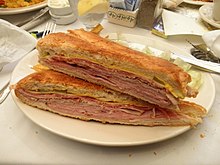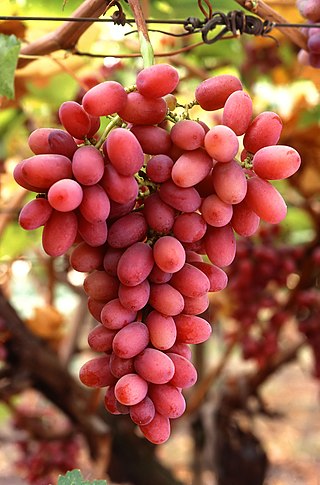Portal:Eating
|
F o o d
| ||||||||||||||
IntroductionFood is any substance consumed to provide nutritional support for an organism. Food is usually of plant, animal or fungal in origin, and contains essential nutrients, such as carbohydrates, fats, proteins, vitamins, or minerals. The substance is ingested by an organism and assimilated by the organism's cells to provide energy, maintain life, or stimulate growth. Different species of animals have different feeding behaviours that satisfy the needs of their unique metabolisms, often evolved to fill a specific ecological niche within specific geographical contexts. Omnivorous humans are highly adaptable and have adapted to obtain food in many different ecosystems. Historically, humans secured food through two main methods: hunting and gathering and agriculture. As agricultural technologies increased, humans settled into agriculture lifestyles with diets shaped by the agriculture opportunities in their geography. Geographic and cultural differences has led to creation of numerous cuisines and culinary arts, including a wide array of ingredients, herbs, spices, techniques, and dishes. As cultures have mixed through forces like international trade and globalization, ingredients have become more widely available beyond their geographic and cultural origins, creating a cosmopolitan exchange of different food traditions and practices. Today, the majority of the food energy required by the ever-increasing population of the world is supplied by the industrial food industry, which produces food with intensive agriculture and distributes it through complex food processing and food distribution systems. This system of conventional agriculture relies heavily on fossil fuels, which means that the food and agricultural system is one of the major contributors to climate change, accountable for as much as 37% of total greenhouse gas emissions. Addressing the carbon intensity of the food system and food waste are important mitigation measures in the global response to climate change. The food system has significant impacts on a wide range of other social and political issues including: sustainability, biological diversity, economics, population growth, water supply, and access to food. The right to food is a human right derived from the International Covenant on Economic, Social and Cultural Rights (ICESCR), recognizing the "right to an adequate standard of living, including adequate food", as well as the "fundamental right to be free from hunger". Food safety and food security are monitored by international agencies like the International Association for Food Protection, World Resources Institute, World Food Programme, Food and Agriculture Organization, and International Food Information Council, and are often subject to national regulation by institutions, like the Food and Drug Administration in the United States. This is a Good article, an article that meets a core set of high editorial standards.
Beecher's Handmade Cheese is an artisan cheesemaker and retail shop with locations in the Pike Place Market, Seattle, Washington and New York City's Flatiron District. The company was founded by Kurt Beecher Dammeier in 2003 and opened in the Pike Place Market after Dammeier obtained a difficult to obtain storefront lease in the Market. Because Dammeier had never been a cheesemaker, he sought out the assistance of Brad Sinko, who helped run a family cheese-making business in Oregon. A second location was opened in 2011 in the Flatiron neighborhood of Manhattan in New York City. Unlike most artisan cheese makers, Beecher's mainly uses pasteurized milk and operates a high-volume modern production facility, with multiple farms supplying milk. When Beecher's encountered problems in guaranteeing the standard flavor of the milks they were using to make cheese, the company bought their own herds of dairy cattle and farms to ensure control of the cheese products from beginning to end. Beecher's uses various cheese cultures when mixing cheeses, so a cheddar cheese produced by Beecher's may use cultures not normally intended for cheddar cheese production. (Full article...) Selected article -A Cuban sandwich (Spanish: Sándwich cubano) is a variation of a ham and cheese sandwich that likely originated in cafes catering to Cuban workers in Tampa or Key West, two early Cuban immigrant communities in Florida centered around the cigar industry. Later on, Cuban exiles and expatriates brought it to Miami, where it is also very popular. The sandwich is made with ham, roasted pork, Swiss cheese, pickles, mustard, and sometimes salami on Cuban bread. Salami is included in Tampa, where there is a large Italian population, but is not usually included in South Florida. The Cuban sandwich is at the center of a long-running friendly rivalry between Miami and Tampa. As part of that rivalry, the "Historic Tampa Cuban Sandwich" was designated the "signature sandwich of the city of Tampa" by the Tampa City Council in 2012. Read more...Selected ingredient - Brown sugar crystals Brown sugar is a sucrose sugar product with a distinctive brown color due to the presence of molasses. It is either an unrefined or partially refined soft sugar consisting of sugar crystals with some residual molasses content (natural brown sugar), or it is produced by the addition of molasses to refined white sugar (commercial brown sugar). The Codex Alimentarius requires brown sugar to contain at least 88% of sucrose plus invert sugar. Commercial brown sugar contains from 3.5% molasses (light brown sugar) to 6.5% molasses (dark brown sugar) based on total volume. Based on total weight, regular commercial brown sugar contains up to 10% molasses. The product is naturally moist from the hygroscopic nature of the molasses and is often labelled as "soft." The product may undergo processing to give a product that flows better for industrial handling. The addition of dyes or other chemicals may be permitted in some areas or for industrial products. Selected recipe - Bruschetta topped with a tomato salad, caramelized balsamic vinegar, and Grana Padano Bruschetta (/bruːˈskɛtə/, /bruːˈʃɛtə/, Italian pronunciation: [bruˈsketta] ( In Italy, bruschetta is often prepared using a brustolina grill. In the Abruzzo region of Italy a variation of bruschetta made with a salame called ventricina is served. Raw pork products and spices encased in pig bladder are aged and the paste spread on open slices of bread which are sometimes grilled. The dish was developed as a way of salvaging bread that was going stale. In Tuscany it is called fettunta and it is usually served without toppings, especially in November, to taste the first oil of the season. Read more... This is a Featured article, which represents some of the best content on English Wikipedia..
Thomcord is a seedless table grape variety and a hybrid of the popular Thompson Seedless or Sultanina grape (a Vitis vinifera variety) and Concord grape (a Vitis labrusca variety). Thomcord was developed in 1983 by Californian grape breeders working for the Agricultural Research Service (ARS), an agency of the United States Department of Agriculture (USDA), as part of a test to better understand a new seedless grape breeding procedure. Its aromatic, "labrusca" flavor is similar to that of Concord, but mellowed by the mild, sweet taste from Thompson Seedless. Thomcord grows well in hot, dry climates, ripens between late July and mid-August, and tolerates powdery mildew. It is a productive variety, yielding an average of 15.1 kg (33 lb) of grapes per vine, but has produced as much as 30 to 32 kg (66 to 71 lb) per vine in grower trials. The berries weigh between 2.72 and 3.38 g (0.096 and 0.119 oz) and have a medium-thick, blue-black skin that adheres to the fruit, unlike Concord, which has a thick skin that can slip off the pulp easily. The aborted seeds in the fruit body are relatively small, but larger than those in Thompson Seedless. Read more...Selected image -Commercial vineyards have planted more than one million of the ARS-developed Crimson Seedless grapevines. Selected biography -
Did you know -Related portalsFood topicsThe following are topics relating to food CategoriesThe following are categories relating to food.
Food list articles
The following are some Food list articles on Wikipedia:
Things you can doRelated WikiProjects
New articlesThis list was generated from these rules. Questions and feedback are always welcome! The search is being run daily with the most recent ~14 days of results. Note: Some articles may not be relevant to this project. Rules | Match log | Results page (for watching) | Last updated: 2020-11-01 19:31 (UTC) Note: The list display can now be customized by each user. See List display personalization for details.
Associated WikimediaSourcesPortals |
||||||||||||||
This page was last updated at 2020-11-02 18:24 UTC. Update now. View original page.
All our content comes from Wikipedia and under the Creative Commons Attribution-ShareAlike License.



























